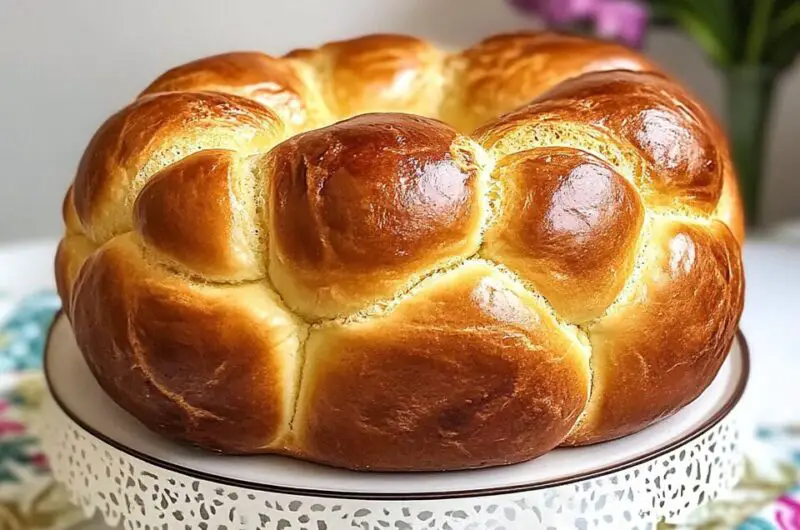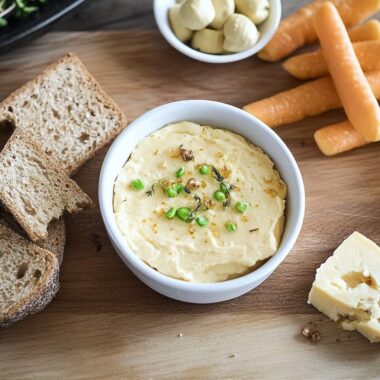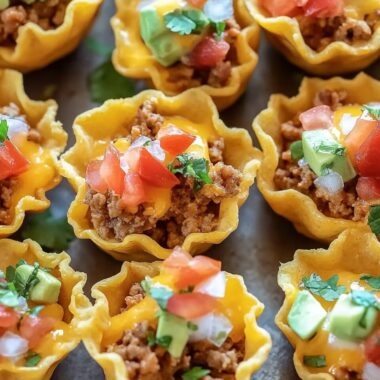Ukrainian Paska is more than just bread it’s a symbol of Easter, tradition, and heritage. This lightly sweetened, golden-brown bread is beautifully adorned with braids and a cross, making it as visually stunning as it is delicious. Its soft, fluffy crumb and subtle vanilla aroma make it the perfect companion to your Easter meal, whether enjoyed plain or with butter and honey. Historically, Paska was taken to church in a special basket to be blessed before the Easter feast. Today, baking Paska continues to be a cherished tradition in many families, passed down through generations. Whether you are reviving an old family recipe or trying it for the first time, this bread will bring warmth, joy, and nostalgia to your Easter celebrations.
Full Recipe:
Ingredients:
- 6 – 7 cups bread flour (or high-protein all-purpose flour)
- 4 teaspoons active dry yeast (2 packets)
- 5 tablespoons granulated sugar
- 1 ½ cup warm milk
- ½ cup butter, softened
- 2 ¼ teaspoon salt
- 3 large eggs, at room temperature
- 1 teaspoon vanilla extract
- 1 egg yolk + 1 teaspoon water (for egg wash)
Directions:
- In a small bowl, warm ½ cup of the milk to 110°F. Stir in 1 teaspoon of sugar and sprinkle the yeast on top. Let sit for 5-10 minutes until bubbly.
- In a large mixing bowl (or stand mixer bowl), whisk together 5 ¾ cups of flour, salt, and remaining sugar. Add the yeast mixture, eggs, softened butter, remaining milk, and vanilla.
- Knead the dough in a stand mixer for 5-6 minutes or by hand for about 10 minutes, until soft, smooth, and slightly tacky. Add extra flour, one tablespoon at a time, if needed.
- Transfer the dough to a greased bowl, cover with plastic wrap or a towel, and let it rise in a warm place until doubled (about 60-90 minutes).
- Lightly grease a 9-inch springform pan. Punch down the dough and divide it into two portions. Shape one half into a disk and place it in the bottom of the pan.
- Divide the remaining dough into four pieces: one piece for the cross and three for braiding.
- Roll three pieces into 18-20 inch ropes, braid them together, and place around the edges of the pan. Shape the last piece into a cross and place in the center.
- Cover and let the dough rise until almost doubled. Meanwhile, preheat the oven to 350°F (175°C).
- Brush the top with egg wash, then bake for 40-50 minutes. If browning too quickly, cover with foil or parchment.
- Cool in the pan for 10 minutes, then transfer to a wire rack to cool completely.
Prep Time: 20 minutes | Cooking Time: 40-50 minutes | Total Time: 2.5-3 hours
Kcal: 250 kcal per serving | Servings: 8-10
Paska: The Traditional Ukrainian Easter Bread
Easter is a time of joy, celebration, and tradition, and for many Ukrainian families, one of the most beloved symbols of the holiday is Paska a beautifully braided, lightly sweetened bread with deep cultural and religious significance. Paska is not just a baked good; it is a representation of heritage, faith, and togetherness, passed down through generations.
The History and Significance of Paska
Paska has been a staple of Ukrainian Easter traditions for centuries. The word “Paska” itself comes from the Greek “Pascha,” which means Passover. In Christian tradition, Easter is the most significant religious holiday, symbolizing the resurrection of Jesus Christ. Paska, as an Easter bread, holds spiritual meaning, often decorated with symbolic braids and a cross to represent the faith of those who bake it.
Traditionally, Ukrainian families would prepare Paska in the days leading up to Easter. The bread was made in large quantities, as it was meant to be shared with family, friends, and even neighbors. It was common for families to take their freshly baked Paska to church on Easter Sunday in a specially prepared food basket. This basket would be filled with other Easter essentials like dyed eggs (krashanky or pysanky), butter, cheese, salt, and meat, all of which would be blessed by a priest before being eaten at the Easter feast.
Paska is also unique because it is more than just food it is a symbol of abundance, hope, and renewal. Many believe that the quality of their Paska bread will reflect their fortune for the coming year. If the bread turns out light, fluffy, and golden, it is a sign of a good year ahead. Conversely, if it does not rise properly or burns, some consider it bad luck.
How Paska Differs from Other Easter Breads
Many cultures around the world have their own variations of Easter bread. Some of the most famous include:
- Kulich (Russian and Ukrainian) – A taller, cylindrical Easter bread that is slightly denser and often topped with icing and sprinkles.
- Babka (Polish and Ukrainian) – A sweet bread that is often swirled with cinnamon, chocolate, or fruit fillings.
- Tsoureki (Greek) – A soft, braided bread flavored with mahleb and orange zest, sometimes topped with red-dyed eggs.
- Panettone (Italian) – A Christmas and Easter bread that is light and fluffy, packed with dried fruits and nuts.
What makes Paska unique is its soft yet rich texture, mild sweetness, and elaborate decorations. Unlike Kulich, which is typically topped with icing, Paska is adorned with carefully shaped dough braids, crosses, and other symbols before baking. These decorations not only make the bread visually stunning but also add to its spiritual and cultural significance.
Traditional Methods of Baking Paska
The process of making Paska has remained largely unchanged for generations. In traditional Ukrainian households, baking Paska was considered a sacred act, requiring patience, skill, and a bit of luck. Many families followed strict customs while preparing their dough, such as:
- Baking in silence – Some believed that noise or distractions could cause the bread to collapse.
- Saying a prayer before starting – Asking for a successful bake was common.
- Avoiding negative thoughts – Many believed that a baker’s emotions could affect the dough’s rise.
Another fascinating tradition is the use of special wooden molds for baking. Some families use heirloom wooden or metal pans that have been passed down for generations. The round shape of Paska represents eternity and the cycle of life, further reinforcing its spiritual symbolism.
Modern Adaptations and Variations
While the traditional Paska recipe remains popular, modern variations have emerged over time. Some bakers like to add raisins, orange zest, honey, or even saffron for extra flavor. Others experiment with different shapes and sizes, creating mini Paska loaves that are perfect for gifting.
Another modern adaptation is vegan Paska, which substitutes eggs, milk, and butter with plant-based alternatives. This version allows those with dietary restrictions to enjoy the beloved Easter tradition without compromising on taste.
For those with limited time, some bakers opt for a bread machine version, letting the machine handle the kneading and first rise before shaping the dough manually for decoration.
Serving and Pairing Suggestions
Paska is traditionally served on Easter morning or during Easter dinner. After being blessed at church, the bread is sliced and shared among family members, often spread with butter, honey, or jam. Some enjoy it as part of a larger meal, pairing it with smoked meats, cheeses, and eggs.
Beyond Easter, Paska makes an excellent breakfast or afternoon snack. It can be toasted and served with coffee or tea, or even repurposed into French toast for a delightful post-holiday treat.
Cultural Significance in the Ukrainian Diaspora
For Ukrainians living outside of Ukraine, baking Paska is a way to stay connected to their roots and pass down family traditions. Many Ukrainian communities in Canada, the United States, and Australia hold Easter baking workshops, teaching younger generations the art of making Paska.
The tradition has also been preserved through Ukrainian churches and cultural centers, which organize annual Easter celebrations featuring traditional foods, music, and religious ceremonies.
In recent years, as Ukrainian cuisine gains global recognition, more people outside the community are discovering and appreciating the beauty of Paska. Food bloggers, chefs, and home bakers worldwide are sharing their own Paska recipes, ensuring that this cherished tradition continues to thrive.
Conclusion:
Paska is more than just a bread it is a symbol of faith, tradition, and togetherness. Its rich history, intricate decorations, and deep cultural significance make it a beloved part of Ukrainian Easter celebrations.
Whether you follow a traditional recipe passed down through generations or experiment with modern variations, baking Paska is a rewarding experience that connects you to history and family. As you knead the dough, braid the design, and watch it rise in the oven, you are not just baking you are continuing a tradition that has stood the test of time.
So this Easter, gather your loved ones, roll up your sleeves, and bake a beautiful Paska to celebrate renewal, hope, and joy. Whether you enjoy it plain, with butter, or as part of a festive Easter feast, this special bread is sure to bring warmth and meaning to your table.








